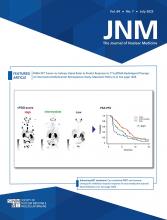Discussions with leaders: Czernin and Bengel interview Franz Weidinger, president of the European Society of Cardiology, about his career in advancing cardiac medicine initiatives.
Page 998
FAPI-based radionuclide therapy: Ora and colleagues summarize the current status of preclinical and clinical fibroblast activation protein inhibitor–based radionuclide therapies, as well as associated dosimetry, safety profiles, and efficacy.
Page 1001
Theranostics in hematooncology: Buck and colleagues provide an educational overview of radiopharmaceuticals for treatment of hematologic neoplasms, potential for targeted theranostic agents, and advantages and disadvantages of lymphoma treatment using radioimmunoconjugates.
Page 1009
Immuno-PET in liver cancer: Fayn and colleagues develop and evaluate glypican-3–selective single-domain antibody PET probes for imaging liver tumors, with superior in vivo target engagement and pharmacokinetic properties.
Page 1017
PSG score and [177Lu]PSMA response: Hotta and colleagues test a quantitative and visual PSMA PET tumor-to-salivary gland ratio in prediction of outcomes after [177Lu]PSMA treatment in a cohort of patients with metastatic castration-resistant prostate cancer.
Page 1024
Biopsy before PSMA PET: Kesler and colleagues evaluate clinical characteristics and PSMA PET-based staging of elderly prostate cancer patients without preimaging biopsy results, explore whether biopsy status affects therapeutic approach, and propose a relevant decision-making algorithm.
Page 1030
Late PSMA SPECT improves detection: Berliner and colleagues compare postinjection imaging timepoints in [99mTc]Tc-PSMA-I&S SPECT/CT detection of lymph node metastases in early biochemically recurrent prostate cancer.
Page 1036
68Ga-FAPI PET interobserver agreement: Mei and colleagues prospectively assess interobserver agreement and accuracy for 68Ga-fibroblast activation protein inhibitor PET/CT interpretations in different tumor entities and compare findings among readers with various levels of experience.
Page 1043
68Ga-FAPI PET/CT in cholangiocarcinoma: Pabst and colleagues report on the accuracy of PET/CT with the novel cancer fibroblast–directed 68Ga-fibroblast activation protein inhibitor-46 tracer for cholangiocarcinoma staging and management guidance.
Page 1049
PRRT and ICIs in NETs: Esfahani and colleagues investigate whether combining peptide receptor radionuclide therapy using [177Lu]DOTATATE and immune checkpoint inhibition therapy improves treatment response in a preclinical neuroendocrine tumor model.
Page 1056
Tetravalent theranostic chelators: Abou and colleagues evaluate antibody-chelator conjugates for stability using ofatumumab, a human anti-CD20 antibody, and explore tumor targeting with a 227Th chelator conjugate in mice, highlighting potential for quantitative imaging and treatment.
Page 1062
Assessing PSMA-GCK01: Cardinale and colleagues detail development of a PSMA-targeted 99mTc/188Re theranostic tandem and summarize preclinical results and initial first-in-humans applications in metastatic castration-resistant prostate cancer.
Page 1069
PET imaging surrogate for 225Ac: Bobba and colleagues determine the potential of positron-emitting 134Ce/134La as a surrogate for 225Ac in PET imaging, including chelation processes, imaging and distribution characteristics, and assessment of 134Ce-labeled tumor-targeting agents in prostate cancer models.
Page 1076
Scintigraphic changes after tafamidis: Papathanasiou and colleagues perform a comprehensive analysis of visual, semiquantitative, and quantitative measures of 99mTc-DPD imaging uptake in patients with cardiac transthyretin-type amyloidosis undergoing transthyretin stabilizer therapy.
Page 1083
18F-FET PET/MR for brain tumors: Smith and colleagues report on clinical application of hybrid 18F-FET PET/MRI in patients with malignant brain tumors to differentiate disease progression from treatment-related changes, identifying complementary information from the combined modalities.
Page 1087
18F-FET PET in recurrent brain tumors: Galldiks and Langen provide perspective on growing data supporting the use of PET with radiolabeled amino acids and advanced perfusion-weighted MRI methods and preview a related article in this issue of JNM.
Page 1093
Activity infiltration in PET: Sunderland and colleagues report on a large multicenter study of dose infiltration using PET imaging to provide dose estimates taking into account specific infiltration geometries and the impact of tissue radiosensitivity.
Page 1095
Voxel-based dosimetry for radioembolization: Watanabe and colleagues analyze whether voxel-based dosimetry can be more accurate in predicting hepatotoxicity in patients with hepatocellular carcinoma undergoing radioembolization with 90Y glass microspheres.
Page 1102
Variabilities in dosimetry calculations: Brosch-Lenz and colleagues assess the source and magnitude of variability in absorbed dose estimates for organs and lesions, in response to the SNMMI 177Lu Dosimetry Challenge and to inform standardization efforts.
Page 1109
MIRDcalc, a community dosimetry tool: Kesner and members of an SNMMI special committee on medical internal radiation dose describe a new and freely available computational tool (MIRDcalc, version 1) intended to support organ-level and suborgan tissue dosimetry.
Page 1117
Dosimetry in advanced thyroid cancer: Taprogge and colleagues analyze quantitative increases in radioiodine uptake due to selumetinib, absorbed doses delivered to metastatic disease from fixed levels of administered activity, and predictive contributions from pretherapy diagnostic studies.
Page 1125
Optimal SPECT of 224Ra and 212Pb: Mikalsen and colleagues detail studies intended to elucidate the feasibility and suitability of SPECT/CT imaging in an α-particle therapy trial using 1–7 MBq of 224Ra, including development of an extensible optimizing routine.
Page 1131
161Tb and radiolabeling for the clinic: Favaretto and colleagues characterize 161Tb and outline a protocol for synthesis and quality control of 161Tb-DOTATOC with a fully automated process conforming to Good Manufacturing Practice guidelines.
Page 1138
Whole-body PET motion correction: Shiyam Sundar and colleagues introduce the Fast Algorithms for Motion Correction software, which allows correction of both rigid and nonlinear motion artifacts in dynamic whole-body images, irrespective of PET/CT system or tracer.
Page 1145
Total-body PET lung kinetic modeling: Wang and colleagues investigate the need for additional corrections to the input function for kinetic modeling in high-temporal-resolution dynamic PET imaging of the lungs.
Page 1154
FAPI PET in tenosynovial giant cell tumor: Sellmann and colleagues present a case study demonstrating the high sensitivity of [68Ga]Ga-fibroblast activation protein inhibitor PET/CT in detecting previously unknown tumors.
Page 1162
- © 2023 by the Society of Nuclear Medicine and Molecular Imaging.







